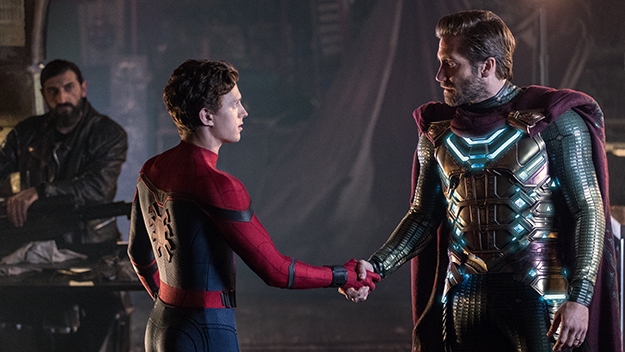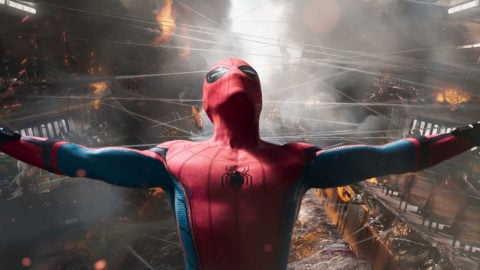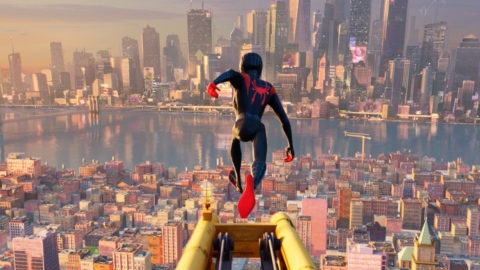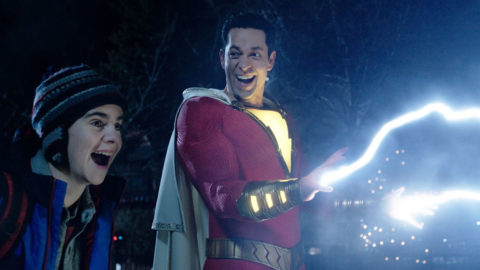Deep Focus: Spider-Man: Far from Home

Spider-Man: Far from Home (Jon Watts, 2019)
The last terrific live-action web-slinger extravaganza, Sam Raimi’s Spider-Man 2 (2004), was a majestic comic-book grand opera. Jon Watts’s Spider-Man: Far from Home is an effervescent comic-book light opera—complete with disguises and illusions, shifting allegiances, real wisdom from fake or disreputable characters, rib-tickling contrasts between romantic couples, and swift epic reversals that put the universe in and out of balance. At one point, we enter a Prague opera house for a performance of Smetana’s The Devil’s Wall. But this wacky, beguiling movie is more like The Magic Tin Flute. Watts’s Spider-Man: Homecoming (2017) was an overstuffed grab-bag. Spider-Man: Far from Home takes a huge leap upward.
In Chris McKenna and Erik Sommers’s playful libretto, er, script, Tom Holland’s innocent, reflexively kinetic Peter Parker, after five years lost to the Snap (here known as “the Blip”), tries to recover from his mentor Tony Stark/Iron Man’s death and take a time-out from being Spider-Man. (The Snap, or the Blip, is what happened when Marvel uber-villain Thanos snapped his gauntleted fingers and instantly offed half the population of the universe, at the end of Avengers: Infinity War.) On a high school field trip to Europe (Peter and the other Blip survivors haven’t aged), he focuses on finding the right spot to announce his deep affection for deadpan-droll and lissome MJ (Zendaya). In Venice he buys her a Black Dahlia necklace—a match for her mordant worldview—and hopes to hand it to her in Paris.
“You look really pretty,” Peter tells MJ at the opera in Prague. “And therefore I have value?” she responds. But she’s “just messing” with him. The movie excels at the awkwardness that generates teen wit—and the unexpected chemistry that spurs on teen confidence. It’s amusing to see Peter’s best friend and Spider-Man’s super-enthusiast Ned Leeds (Jacob Batalon), who daydreams of hooking up with European girls, strike sparks with deceptively prim classmate Betty Brant (Angourie Rice) and emerge (in his mind, anyway) as a seasoned boy of the world. Betty is so proper she already sports a single strand of pearls.

The movie unfolds as an updated, unpredictable meld of National Lampoon’s European Vacation and 1950s sci-fi about giant creatures molesting world-class cities—though ‘50s movies usually targeted a single metropolis like Tokyo, New York, or San Francisco, instead of divvying up outlandish spectacle equally among Venice, Prague, and London. Former SHIELD director Nick Fury (Samuel L. Jackson) pulls Peter back into the planet-saving business when four monstrous titans, “Elementals,” materialize seemingly out of nowhere and summon the destructive powers of one element each: earth, wind, air, and fire. Quentin Beck (Jake Gyllenhaal) arrives at the same time in an armored super-suit, with cape-clasps that resemble the Eye of Providence pyramid on the dollar bill and a helmet like a fogged-up fishbowl. He says he’s the sole survivor of an Earth destroyed by Elementals in the Multi-Verse.
In one crowd-pleasing interchange, Peter protests to Fury, “I’m just your friendly neighborhood Spider-Man, sir,” and Fury responds, in full scowl, “Bitch, please, you’ve been to space.” But the key line comes when Quentin, happy playing big brother to Peter after losing his own family, tells Peter that Fury was sorry for snapping at him—then adds, “You guys do have sarcasm on this Earth, right?” Gyllenhaal has been cast to perfection. He’s got the ideal combination of amiability and intensity. His streak of bizarre humor combines with intrigue when he cocks his eyes at the first suggestion that his public name should be “Mysterio.” Peter spends most of the film protecting his classmates from Elementals without giving his secrets away while discovering whether Mysterio can substitute for his dead mentor Stark.
Under Watts’s open-to-improv direction, Gyllenhaal and the rest of the cast imbue this film with something better than sarcasm: a cheerful sense of irony in all its forms, from paradox and incongruity to characters saying one thing and meaning the opposite. The movie nails its affable tone early on: Betty and her cohost on the in-house videocast of the Midtown School of Science and Technology air a hilariously pseudo-slick “In Memoriam” segment saluting fallen Avengers to the tune of Whitney Houston singing “I Will Always Love You.” High-school frustrations about students forced to restart the academic year to accommodate the Blip surface in the cohosts’ banter. But neither that spurt of irreverence nor the video’s over-the-top earnestness can match our delight in the teenagers’ resilience. Nor does it undercut our feelings for Tony Stark/Iron Man to learn that when he bequeaths super-duper glasses to Peter that can operate his billionaire defense systems, the name of its AI persona, EDITH, stands for “Even Dead I’m the Hero.”

Watts encourages the actors to satirize or push beyond stereotypes, so the vivacious Marisa Tomei as Peter’s Aunt May can be equally and simultaneously persuasive as his doting guardian, slipping his Spidey suit into his suitcase; a lifelong community organizer raising funds for people displaced, jobless, or homeless because of the Blip; and a love object for the late Tony Stark’s driver and right-hand man, Happy Hogan (Jon Favreau). The relaxed and jovial Favreau and sharp, intuitive Tomei share a more casual, Queens-style chemistry than Robert Downey Jr. and Gwyneth Paltrow do in Favreau’s Iron Man movies (the major influence on this film). And Jackson’s Fury clicks with Cobie Smulders’s Maria Hill: her dry awareness soaks up his bombast. Add J.B. Smoove (Top Five, Curb Your Enthusiasm) and Martin Starr (Silicon Valley) as the students’ chaperones—respectively, a science teacher who believes in witches and a team leader who knows he’s incapable of counseling—and you’ve got a cast that turns a school bus into a sophisticated sort of clown car.
This director’s spectacular visual instincts exploit picturesque locations like St. Mark’s Square in Venice and the Tower of London both for travelogue awesomeness and for sci-fi dread. The costume team contributes its share of pizazz, especially when Peter hides his Spider-Man identity in an all-black stealth suit with flip-up goggles; Ned helpfully calls this “new” figure “Night Monkey” and the moniker sticks with gobsmacked Europeans. Watts’s greatest skill, though, is knowing how to gear up and time the action not just for humor but also for meaning. It’s intriguing that he cuts away at the start from Quentin Beck confronting the Air Elemental. Watts plants questions that pay off later.
Aunt May and Happy Hogan refer to Peter’s Spider-Sense as the “Peter-Tingle.” Watts’s operates his own Spider-Sense with a wink and a smile. What makes Spider-Man: Far from Home so consistently entertaining is that this director blends Peter-Tingle and Peter-Tickle. Even after a preview of disasters to come, we exit laughing.
Michael Sragow is a contributing editor to Film Comment and writes its Deep Focus column. He is a member of the National Society of Film Critics and the Los Angeles Film Critics Association.







